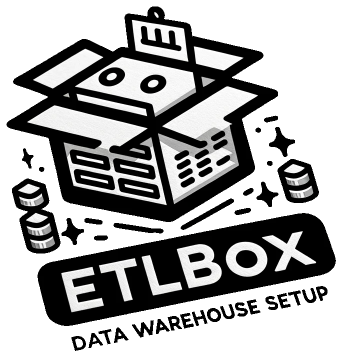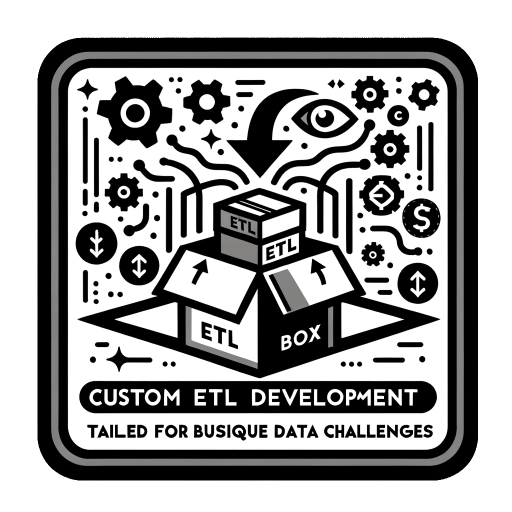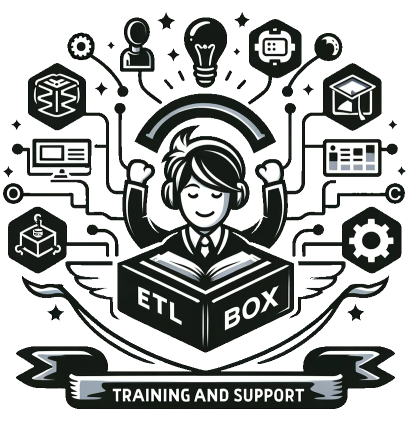At ETLBoxperts, we provide a comprehensive range of services designed to optimize your data management and processing needs. Using the power of ETLBox, our team of experts delivers solutions that not only meet but exceed your expectations.
Explore our services to see how we can transform your data into a valuable asset.

Data Warehouse (DWH) Setup
Setting up a Data Warehouse is critical for effective data management and analytics. We guide you through the entire process, utilizing ETLBox’s capabilities for efficient data storage and retrieval. Our approach ensures that your DWH is scalable, secure, and tailored to your specific needs.
Interested in setting up a robust DWH? Contact us to learn more.
A Data Warehouse (DWH) is a centralized repository designed to store integrated data from multiple sources. It is a foundational component of business intelligence and plays a crucial role in data-driven decision-making. The key characteristics and functions of a Data Warehouse include:
Integration of Data: DWHs consolidate data from various sources, such as transactional databases, CRM systems, and other operational software. This integration enables a unified view of information, essential for comprehensive analysis and reporting.
Subject-Oriented: Unlike operational systems that focus on specific business processes (like sales, finance, or marketing), a Data Warehouse is organized around key subjects such as customer, product, or sales. This organization helps in analyzing data across different segments of the business.
Time-Variant: Data in a DWH is stored with a time dimension, meaning historical data is kept for analysis over time. This aspect is crucial for identifying trends, patterns, and long-term performance analysis.
Non-Volatile: Once data is entered into the DWH, it is not changed or deleted. This ensures the consistency of historical data, which is vital for accurate trend analysis and forecasting.
Performance and Scalability: Data Warehouses are optimized for reading, aggregating, and querying large sets of data. They are designed to handle complex queries and deliver fast performance while scaling to accommodate growing data volumes.
Some of the key benefits are:
- Improved Decision Making: By having a consolidated view of data from across the organization, businesses can make more informed decisions.
- Enhanced Data Quality and Consistency: DWHs involve data cleaning and integration processes that improve data quality and consistency.
- Historical Intelligence: Since DWHs store historical data, they enable businesses to analyze trends over time and make predictive analyses.
- Efficient Reporting and Analysis: DWHs are optimized for complex queries and report generation, making them ideal for business intelligence activities.
A Data Warehouse is a strategic tool that aggregates data from various sources into a single, coherent framework. It is instrumental in providing actionable insights, supporting business intelligence activities, and enabling data-driven decision-making.
Data Vault is a modern data warehousing architecture and methodology that was developed by Dan Linstedt. It’s designed to address some of the challenges in traditional data warehousing, such as rigidity, scalability issues, and adaptability to change. Key components and principles of Data Vault include:
- Hub, Link, and Satellite Structures:**
- Hub: Represents the core business concepts (like Customer or Product). Hubs contain unique business keys.
- Link: Manages the relationships between Hubs. It’s used to join different business concepts together.
- Satellite: Holds the descriptive attributes (context) related to Hubs or Links, capturing changes over time.
- Historization: Data Vault keeps a detailed history of all changes. Each record in a Satellite has a timestamp, providing a full audit trail and enabling time-based analysis.
- Scalability and Flexibility: The Data Vault model easily adapts to changes in business requirements and can handle large volumes of data. It’s designed to be scalable in both size and complexity.
- Separation of Business and Technical Keys: It separates business keys (natural keys from source systems) and technical keys (surrogate keys), ensuring robustness in data linking and tracking.
- Ensemble Modeling: This is a unique modeling technique in Data Vault that involves building small, reusable parts of models (like Hubs, Links, Satellites) which can be combined in various ways to respond to changing business needs.
Benefits of Data Vault:
- Agility: The modular design allows for quick and easy changes to the data model without disrupting the entire system.
- Data Integrity and Quality: Maintains a high level of data quality and integrity, even in complex scenarios with data from multiple sources.
- Auditability and Compliance: Every piece of data can be traced back to its source, which is crucial for compliance and auditing purposes.
- Future-proof: The architecture is robust enough to handle future changes in technology and business requirements.
In summary, Data Vault is a comprehensive approach to data warehousing that offers significant advantages in terms of flexibility, scalability, and reliability. It’s particularly suited for large enterprises with complex data needs and environments that require the ability to quickly adapt to change.
A Data Lake is a centralized repository that allows you to store all your structured and unstructured data at any scale. It can store data in its raw form and doesn’t require a predefined schema, making it highly flexible and adaptable. Key characteristics of a Data Lake include:
- Storage of Diverse Data Types: Data Lakes can store a vast range of data types, including unstructured data (like text and images), semi-structured data (like JSON, XML files), and structured data (like databases).
- Scalability: They are designed to scale easily, handling massive amounts of data — from terabytes to petabytes.
- Flexibility: Data can be stored in its native format without needing to fit into a predefined schema. This means you can store all your data without knowing in advance what insights you might want to extract.
- Cost-Effective Storage Solutions: Data Lakes often use low-cost storage solutions, making it economical to store large volumes of data.
- Advanced Analytics and Machine Learning: The diverse and extensive datasets in Data Lakes make them ideal for complex analytical tasks, including big data processing, machine learning, and real-time analytics.
Benefits of a Data Lake:
- Centralized Data Repository: Offers a single store for all of the organization’s data, making data management simpler and more efficient.
- Supports All Data Types: Capable of storing unstructured, semi-structured, and structured data.
- Enhanced Data Discovery and Analysis: Facilitates data discovery, analytics, and reporting with advanced tools and applications.
- Agility: Provides the ability to adapt quickly to changing analysis requirements.
In summary, a Data Lake is a highly scalable, flexible solution for storing and analyzing diverse data types. It’s particularly beneficial for organizations looking to perform advanced analytics and leverage big data for strategic insights. However, it requires careful management to ensure the data remains accessible and valuable.
ETLBox is a highly versatile and powerful data integration library for .NET, designed to excel in a variety of data management scenarios, including Data Lakes, Data Warehouses (DWH), and Data Vault architectures.
- Data Lake Support:
- ETLBox is adept at handling a broad spectrum of data lake technologies. Its proficiency in managing diverse data types and formats makes it ideal for the dynamic environment of a Data Lake.
- Whether it’s integrating with Cosmos DB, cloud-based storage like Azure Data Lake Storage, or other platforms, ETLBox offers robust functionalities to efficiently extract, transform, and load data, thereby enhancing the utility and accessibility of Data Lakes.
- Data Warehouse (DWH) Support:
- In the realm of traditional Data Warehousing, ETLBox shines with its ability to manage complex ETL processes. It is perfectly equipped to handle the structured nature of DWH data, supporting efficient data transformation and loading.
- ETLBox simplifies the process of populating, maintaining, and updating a Data Warehouse, ensuring that data is processed and stored effectively for analysis and reporting.
- Data Vault Support:
- ETLBox’s flexibility and powerful ETL capabilities make it highly suitable for Data Vault architectures. It can adeptly handle the intricacies of Data Vault modeling, including the management of Hubs, Links, and Satellites.
- The library’s adaptability allows it to cater to the unique needs of Data Vault methodology, supporting the robust, historical, and auditable nature of Data Vault systems.
ETLBox’s comprehensive support for these diverse data management architectures makes it a valuable tool for any organization looking to use the power of their data. Whether dealing with the vast and varied data of a Data Lake, the structured environment of a DWH, or the complexity of a Data Vault, ETLBox provides the necessary flexibility, power, and efficiency to meet and exceed requirements in these scenarios.

Data Integration Solutions
In the digital age, seamless data integration is key to business success. We offer comprehensive solutions for data migration, integration, and optimization. Our services ensure that your data is consistent, accurate, and readily accessible across various platforms.
For seamless data integration, Reach out to us today.
Data Integration is the process of consolidating data from multiple sources into a single, cohesive dataset. This practice is essential in today’s data-driven world where organizations collect information from various systems and platforms. Key aspects of Data Integration include:
- Data Collection: Gathering data from diverse sources, which could be internal systems like CRMs and ERPs, or external sources like social media platforms and third-party services.
- Data Transformation: Converting the collected data into a format that is consistent and usable. This step often involves standardizing data formats, correcting inconsistencies, and resolving conflicts to ensure data quality.
- Data Consolidation: Combining data from different sources into a unified format or database. This can be achieved through various techniques like ETL (Extract, Transform, Load), data virtualization, or data warehousing.
- Data Cleaning: Ensuring the integrated data is accurate and free of errors or duplications. This step is crucial for maintaining the integrity and reliability of the data.
Benefits of Data Integration are:
- Comprehensive Insights: By bringing together data from various sources, organizations can gain a more complete and nuanced understanding of their operations, customer behaviors, and market trends.
- Improved Decision Making: Integrated data provides a holistic view, enabling better-informed decisions based on comprehensive information.
- Increased Efficiency: Data Integration automates the process of gathering and consolidating data, saving time and reducing the likelihood of errors compared to manual processes.
- Enhanced Data Quality: The process often includes steps to clean and standardize data, leading to higher data quality and reliability.
In summary, Data Integration is a fundamental process in the realm of data management, crucial for turning disparate data into actionable insights and strategic decisions. It’s a key enabler for organizations seeking to leverage their data assets fully.
An API is a set of rules, protocols, and tools for building software and applications. It specifies how software components should interact. Essentially, an API defines the way in which different software programs can communicate and share data and services with each other. Here are some key aspects:
- Interface Between Different Software Applications: APIs enable separate software systems to communicate and interact. For instance, when you use a social media app on your phone, it uses an API to communicate with the server to retrieve and send data.
- Simplifying Development and Integration: APIs abstract the underlying complexity of a service or system. Developers can use APIs to integrate functionality without needing to understand the detailed inner workings of the systems they’re interacting with.
- Types of APIs: There are various types of APIs, including web APIs, operating system APIs, database APIs, and more. Web APIs are particularly common, allowing applications to interact over the internet. Very common are REST (Representational State Transfer) web APIs. REST is widely used due to its simplicity and compatibility with the web, but there are lots of other different approaches like GraphQL, a query language for accessing the API.
ETLBox stands out for its exceptional support in API and data integrations, leveraging its .NET-based framework. It offers a versatile solution for connecting with various API types, including RESTful and SOAP, making it suitable for diverse integration needs.
Key Features of ETLBox in API Integration:
- Flexible API Connectivity: ETLBox can efficiently extract data from multiple types of APIs, showcasing its adaptability in different integration scenarios.
- Efficient Data Transformation: The library excels at transforming API data, handling tasks like data cleansing, aggregation, and conversion to ensure the data fits the desired format or schema.
- Diverse Data Loading Capabilities: ETLBox supports loading processed data into various destinations, from databases to other APIs, accommodating different requirements for API data integration.
- High-Volume and Velocity Management: Designed to manage large data volumes and high-velocity data flows, ETLBox ensures fast, reliable API data integrations.
- Customization and Extensibility: Its customizable nature allows for tailoring specific to unique API integration requirements and data formats.
ETLBox not only excels in API integrations but also in broader data integration contexts.
Supporting Data Integrations:
- Comprehensive ETL Capabilities: From extracting data from various sources, transforming it to meet business needs, to loading it into target systems, ETLBox covers the entire ETL spectrum.
- Scalability: It can scale to handle increasing data loads, making it suitable for growing businesses.
- Data Integration Automation: ETLBox enables the automation of repetitive and complex data integration tasks, saving time and reducing errors.
ETLBox’s combination of flexibility, efficiency, and scalability makes it a powerful tool for API and general data integration challenges in modern data-driven environments.

Custom ETL Development
Every business has unique data challenges. Our custom ETL development service uses ETLBox to create tailored ETL processes that fit your specific requirements. We focus on building solutions that are not only efficient but also scalable and maintainable.
Discuss your custom ETL needs with us by clicking here.
TDD is a software development process where the developer first writes an automated test case that defines a desired improvement or new function, then produces the minimum amount of code to pass that test, and finally refactors the new code to acceptable standards.
Key Principles of TDD:
- Short Development Cycles: The idea is to write small tests and small pieces of code iteratively. This helps in catching issues early and reduces the need for extensive debugging later.
- Red-Green-Refactor: This mantra describes the TDD process. Red - write a failing test, Green - make the test pass, Refactor - clean up the code while maintaining functionality.
- Focus on User Requirements: TDD requires writing tests based on user requirements, ensuring the development process stays focused on delivering what’s actually needed.
Benefits of TDD:
- Improved Code Quality: Since tests are written first, TDD often leads to better-designed, cleaner, and more reliable code.
- Early Bug Detection: Issues are typically caught early in the development cycle, reducing the cost and effort of fixing them later.
- Enhanced Documentation: The tests serve as documentation of the codebase, making it easier for new developers to understand the functionality of the system.
- Confidence in Refactoring: The comprehensive suite of tests allows developers to refactor code with confidence, knowing that any regression will be caught by the tests.
Test-Driven Development (TDD) is crucial for several reasons, impacting the design, quality, and maintainability of software. Below are the key aspects of TDD’s importance:
- Improves Code Quality and Reliability
- Leads to more careful design and modular code.
- Ensures lower bug rates and higher reliability with tests guiding feature development.
- Facilitates Refactoring and Code Maintenance
- Comprehensive tests allow for confident refactoring and code changes.
- Enhances long-term maintainability with less risk of breaking existing functionality.
- Encourages Simpler, More Focused Code
- Promotes writing only the necessary code to pass tests, resulting in efficiency.
- Prevents over-engineering, keeping the codebase lean and manageable.
- Supports Agile and Iterative Development
- Aligns with agile methodologies emphasizing iterative development and adaptability.
- Allows flexibility in development, accommodating safe changes throughout the project lifecycle.
- Early Bug Detection
- Testing during development leads to early bug detection and resolution.
- Reduces the cost and time associated with late-stage bug fixing.
TDD is important for its impact on both the technical and process aspects of software development. It leads to better code quality, efficient development practices and improved team dynamics.
ETLBox stands out in the ETL landscape due to its unique nature as a code-only library tailored for .NET/C#. This distinction is particularly significant in the context of TDD, and here’s why:
Code-Centric Approach:
- ETLBox is built as a code-only library, meaning all ETL processes are defined and controlled through .NET/C# code. This approach is inherently more compatible with TDD compared to low-code or no-code tools.
- In TDD, tests are written before the actual functional code. ETLBox’s code-centric nature allows developers to seamlessly write unit tests for each ETL component before its implementation, ensuring that each ETL function is thoroughly tested from the outset.
Integration with .NET Testing Frameworks:
- Being a .NET library, ETLBox can easily integrate with various .NET-based testing frameworks like NUnit, xUnit, or MSTest. This integration is essential for implementing TDD, as it allows for the creation of automated and repeatable tests.
- Unlike low-code or no-code platforms, where testing capabilities might be limited or abstracted away, ETLBox allows developers to write custom tests that align precisely with the business logic and data transformation requirements.
Contrast with Low/No-Code Tools:
- Most low-code or no-code ETL tools prioritize ease of use and rapid development over testability. While they offer quick setup and deployment, they often lack the depth required for TDD, making it challenging to implement rigorous, code-level testing.
- ETLBox’s code-only approach fills this gap, providing a robust platform for developers who prioritize testability and reliability in their ETL processes.
ETLBox’s full support for TDD is a distinctive feature that sets it apart in the ETL tool landscape. Its code-centric nature, integration with .NET testing frameworks, and the ability to perform deep, customizable testing make it an ideal choice for teams that adhere to TDD and agile methodologies.

Training and Support
We offer training sessions and post-implementation support to ensure that you get the most out of your ETLBox solutions. Our training is designed to empower your team with the skills needed for ongoing success, while our support ensures you have expert help whenever you need it.
Interested in training or support? Learn more about our offerings.
Maximizing the Utility of ETLBox:
Comprehensive training ensures that your team can fully leverage the capabilities of ETLBox. Understanding the intricacies and potential of the tool allows your team to utilize it to its fullest, thereby optimizing your data management processes.
Empowering the Team with Essential Skills:
Training sessions provide your team with the necessary skills and knowledge to efficiently use ETLBox. This empowerment is key to fostering self-sufficiency within your team, reducing reliance on external help for routine tasks and queries.
Ensuring Effective Implementation:
Proper training is crucial during the implementation phase of ETLBox. It helps in avoiding common pitfalls and ensures that the setup aligns with best practices, thus reducing the likelihood of future issues.
Adapting to New Features and Updates:
The data technology landscape is constantly evolving, and ETLBox is no exception. Regular training sessions help your team stay updated with the latest features and improvements, ensuring that your data processes remain cutting-edge.
Enhancing Problem-Solving Skills:
Through training, team members develop a deeper understanding of how to troubleshoot and solve problems within ETLBox. This skill is invaluable in minimizing downtime and maintaining continuous data operations.
Training and support are not just add-ons but essential services that enhance the effectiveness of ETLBox solutions. They ensure that your team is skilled, the tool is used optimally, and help is available when needed, all of which are key to the success of your data integration and management initiatives.